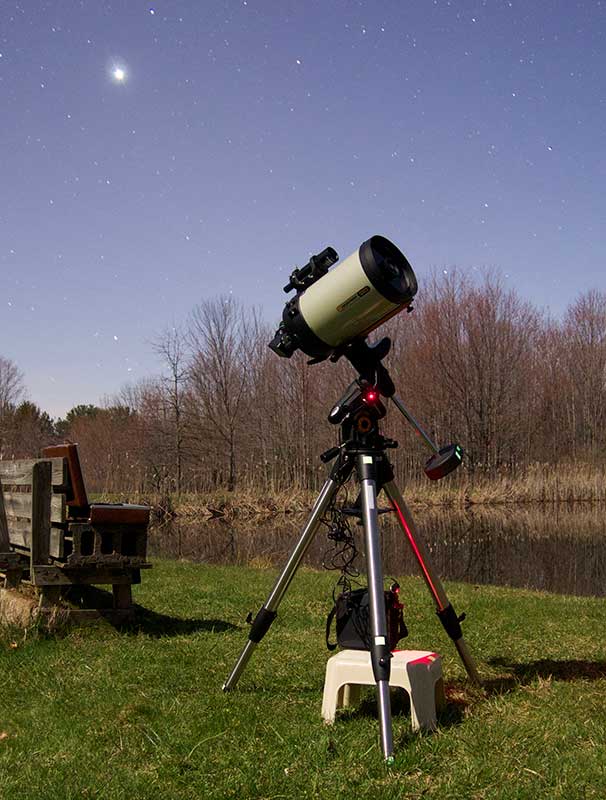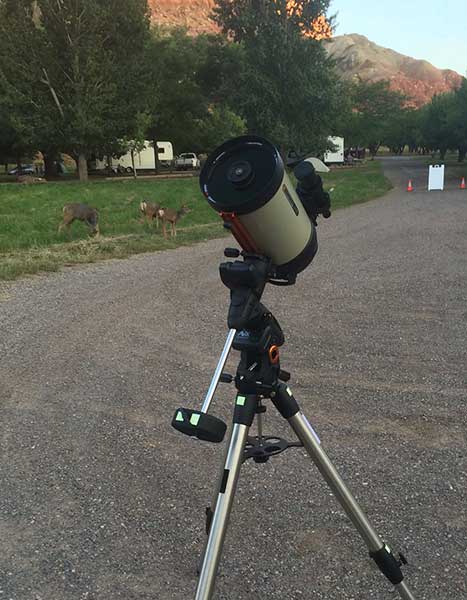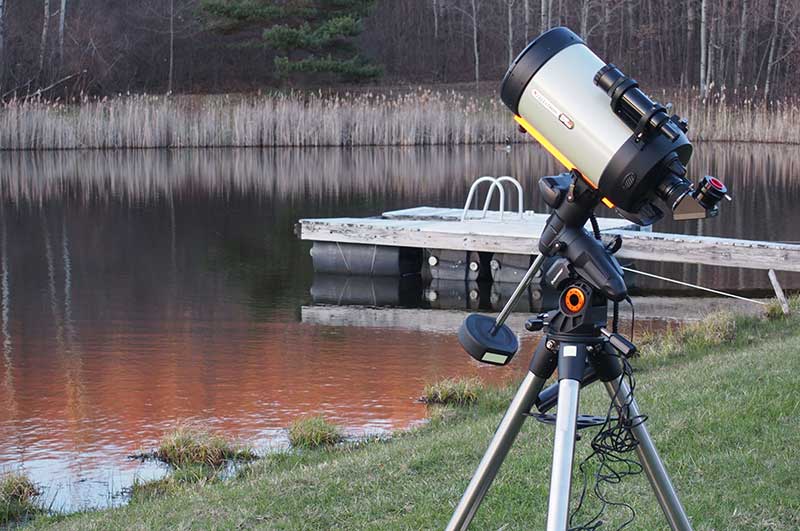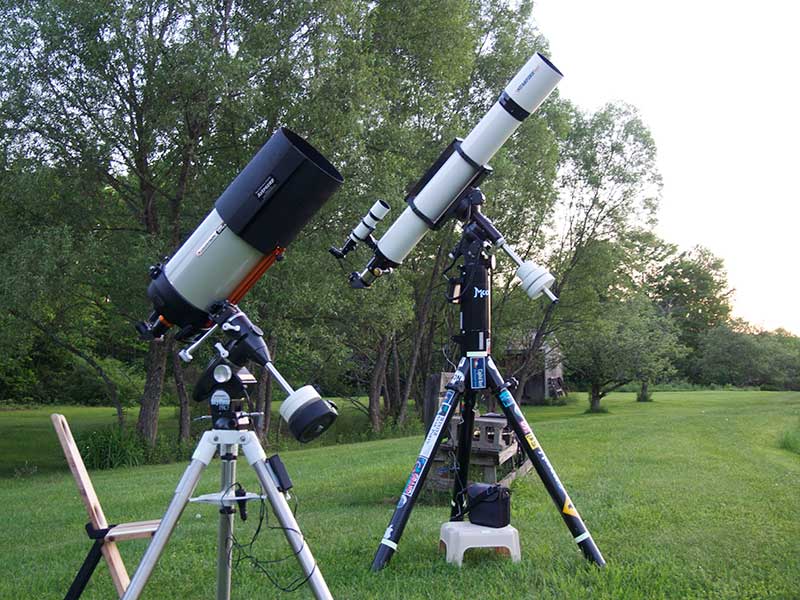Celestron 8-Inch EdgeHD Telescope Review
by Joe Bergeron
by Joe Bergeron
 Allow me to preface
this lengthy, rambling review of the Celestron 8” EdgeHD
Schmidt-Cassegrain telescope with a summary of my earlier
experiences with similar instruments. Okay? Okay.
Allow me to preface
this lengthy, rambling review of the Celestron 8” EdgeHD
Schmidt-Cassegrain telescope with a summary of my earlier
experiences with similar instruments. Okay? Okay.Long ago, in the Before Times, I was wary of Celestron and its stubby Schmidt-Cassegrain telescopes. I had looked through too many bad ones, with poor, unfocusable star images and blank-faced planets. No doubt many of these problems were due to owner cluelessness. One kid had an expensive C-8 bestowed on him by doting parents, yet it couldn’t split Epsilon Lyrae. He was too intimidated to try collimating it.
One older guy just had no idea. Whenever he wanted to find a new target, he would pick up his entire fork-mounted C-8, wedge, tripod, and all, and turn it so its polar axis was pointed roughly at what he wanted to observe. That way he could kinda, sorta track it with the declination knob as it rose or set. In other words, he had no use for the clock drive, the setting circles, or even the wedge. He would have been better off without the wedge altogether. He told me he would figure out polar alignment and equatorial forks and other tricky stuff once he was retired.
Please forgive this digression. That old doofus has bugged me for decades, and I had to get it off my chest. I wonder what he did for a living. If he was a school bus driver, perhaps he operated by loading up the bus, then carrying it to each kid’s house in turn.
Finally, the scopes were orange, one of the least astronomical colors possible, unless you’re obsessed with Mars. Only yellow could be worse.
But then came 1984. Celestron was obliged to update its dated product line by the existence of that presumptuous upstart, Meade Instruments. One of the earliest products of this reluctant renaissance was the modestly-named Super C-8+, which addressed a few long-standing deficiencies in the design. It featured a better drive system (proudly emphasized by a window and bright light in the drive base, to display the worm!), a better finder, and a few other amenities. Also, it was black, a more acceptable color.
My life was in turmoil at the time (as it so often is), I was about to move out of state, and I felt an urge to treat myself. Celestron’s marketing was compelling. I paid something like $1,250 for this darkly gleaming thing, which was a lot of money in 1984, and not exactly peanuts today, either.
It was a good telescope. It was good at splitting double stars. It was good on the Moon. Beyond that, I can’t really say just how good it was, because I wasn’t as smart thirty years ago as I am today. For example, I wasn’t smart enough to buy or make a dewcap, which is utterly necessary for any SCT used in any dampish climate, let alone New York or North Carolina. The scope had “Starbright” coatings, but I was never sure if the corrector was coated at all. Its reflections showed a slightly brownish color, if anything. I liked the way the scope looked, and I often left it set up beside my bed so I could admire its slightly ominous appearance.
But, I never saw anything through that telescope that struck me as excellent. It may have been excellent, but as I say, I was still a bit of a cave-dwelling primitive of an amateur astronomer back then. So, after a couple of years I sold it to a local physician, using the money to help finance the purchase of my first Astro-Physics refractor (the tale of which is not here, but is definitely there, elsewhere on this site).
The decades passed. Thoughts of SCTs were as phantoms that rarely wafted through my mind. The few I happened to look through ranged from abysmal to pretty good. Sometimes I thought about the long-lost Super C-8+ and wished I had it back, just out of curiosity.
The years flit by until we reach the futuristic date of 2014, which found me reprising my role as a Night Sky Ambassador or Master Volunteer Astronomer (astronomy interpreter) at Capitol Reef National Park in Utah, with my very own name tag and everything. The previous year I’d used my 155mm f/9 refractor for these outreach events. It’s a fine outreach scope, but a pain and a hassle to set up and take down every night. It was so inconvenient that whenever the weather looked iffy I sometimes did not set it up at all, only to feel remorse when the weather turned out fine. In 2014 I was using my little 92mm refractor on a small AVX mount for the same purpose. So much easier to set up! But it was too small to provide really impressive views of deep sky objects for park visitors who had no experience of looking through telescopes, even with Capitol Reef’s superbly dark sky.
I began to consider a replacement, a telescope to be used mainly for outreach. My criteria were as follows:
- Not absurdly expensive
- Decent aperture
- Compact and easy to transport in a small car
- Must work well on the AVX mount
- Eyepiece at the bottom, to accommodate visitors ranging in height from wee tykes to, well, me
The more I thought about it, the more some muse whispered “SCT…SCT…” into my waiting ears. This was made louder by the fairly recent introduction of Celestron’s EdgeHD SCT design, which promised (by means of corrective lenses in the main baffle tube) to fix optical issues I didn’t even know the standard SCT possessed, namely coma and field curvature. I was also once again impressed by Celestron’s marketing, and especially by the white paper they published, which detailed the design and construction of the scopes. Thus it was decided. If the renowned Joe Bergeron, Master Volunteer Astronomer, was going to take a chance on the SCT design, it could not be a plebeian standard model. It must be a shiny new EdgeHD.
So…I ordered one from High Point Scientific (on sale, because I like to be prudent in my extravagances). It arrived promptly, was well packed, and was in perfect condition, its optics bright and perfectly clean. I immediately put it to work for outreach. That meant I mainly only glanced through it to find targets for others, but still it was immediately obvious that it was at least a pretty good scope. Over the years I’d heard much about SCTs showing bloated or blurry stars, and I’d seen a few of those myself. Not so with this scope. Stars were very sharp points at all powers, with clearly visible (if rather bright) diffraction rings, all nice and symmetrical. Glimpses of Saturn descending into the twilight were sharp and promising.

The vast increase in image brightness over the 92mm was a boon to my outreach work. I was especially impressed by the views of small planetary nebulae at powers above 200X…bright blue orbs floating in utter blackness. A 35mm Panoptic eyepiece in a 2” diagonal provided wide, bright views of the Lagoon Nebula and its environs. One night a pair of German guys came by and expressed their admiration of this view and telescope. They turned out to be engineers from Zeiss.
Physically the scope is solid and attractive. The tube color is a pale green-tinted grey with a slightly sparkly appearance. This is an unusually subtle color for a telescope. I applaud whoever came up with it. I imagine it was the subject of much discussion at Celestron HQ.
Image shift when focusing is a common complaint about SCTs. Mine has very little, almost none, certainly less than my Questar. I see no need to add any kind of replacement or supplemental focuser. The finder is adequate. The finder base is interesting, an elaborate metal platform that seems bigger than is really required for the job, but that’s merely a quibble. The star diagonal is not very impressive mechanically, but it contains a nicely multi-coated prism that works well. I would have preferred something better than cheap set screws on the diagonal and visual back.
I added a few important accessories: a padded soft case from Pacific Designs, a flexible dewcap, a dew heater strip, and a 2” Clicklock visual back from Baader Planetarium.
After leaving Utah my next good chance to use the telescope was at the 2015 Winter Star Party in the Florida Keys. Because of bad weather and brief opportunities I mainly used it to peer at Jupiter, using powers of 250x and 166x, with excellent seeing. I was impressed and pleased. The disk was very sharp, displaying decent contrast and good detail. It looked about as good as I could reasonably expect from an 8” SCT. Then I walked over to my neighbor’s 7” Astro-Physics refractor. He was using about 300x on Jupiter, plus a binoviewer. Oops! This view was in a whole different league. Razor sharp, crammed with detail, shown with a presence and authority the Edge couldn’t match. It was like seeing Jupiter on an IMAX screen versus seeing it on a good CRT television.
Very well, so the Edge couldn’t begin to match a fine 7” apochromat. That was too much to hope for anyway. I turned the Edge to the Trapezium at 250x. Four stars were cleanly rendered, and the E and F stars were easily visible. Much nebulosity filled the field. The Edge was still a very nice telescope, within the limits of reason.
That comparison naturally whetted my interest in comparing the Edge to my own 155mm Astro-Physics scope. I finally got that chance in early June of 2015, while Jupiter was still high enough to be seen well. I consider that low-contrast object to be the best possible comparison test for the two telescopes. The night wasn’t ideal. Seeing was only fair at best. I used both scopes at around 280X.
 A first
glance at Jupiter revealed two things. One, the Edge was much
brighter than the refractor. Two, the image in the refractor
was much clearer, sharper, and more detailed. This disparity
diminished as the evening progressed and the temperature
stabilized, but the C-8 never caught up to the refractor. The
refractor revealed a tiny grey dot in Jupiter’s equatorial
zone. At first I thought it was a moon shadow, but it turned
out to be the disk of Ganymede transiting the planet. This was
initially invisible in the Edge. It later came into view, but
it was never as obvious as it was in the refractor. The view
in the Edge was, at least at first, a bright white disk with
two featureless equatorial belts. The refractor showed a dark,
narrow belt that was only fleetingly visible in the Edge as
the night wore on.
A first
glance at Jupiter revealed two things. One, the Edge was much
brighter than the refractor. Two, the image in the refractor
was much clearer, sharper, and more detailed. This disparity
diminished as the evening progressed and the temperature
stabilized, but the C-8 never caught up to the refractor. The
refractor revealed a tiny grey dot in Jupiter’s equatorial
zone. At first I thought it was a moon shadow, but it turned
out to be the disk of Ganymede transiting the planet. This was
initially invisible in the Edge. It later came into view, but
it was never as obvious as it was in the refractor. The view
in the Edge was, at least at first, a bright white disk with
two featureless equatorial belts. The refractor showed a dark,
narrow belt that was only fleetingly visible in the Edge as
the night wore on.Jupiter’s moons were sharp in the Edge, but they looked more starlike than moonlike because of their more prominent diffraction rings. The bad seeing affected the two telescopes differently. In the refractor, I saw a sharp image with distinct waves of seeing passing over it. The Edge was simply blurred, with quite a bit of light spilling out from the limb of the planet.
I do not consider this a conclusive comparison. I know the Edge can perform much better than that on Jupiter. For example, previously I compared it against a nice 150mm f/5 Newtonian on a night of fine seeing. In this case the C-8 did very well, easily beating the reflector. It showed the Great Red Spot as a sharp orange oval that looked painted on. But even then, deficits were visible. The equatorial zone was a blank white, when normally the 155mm refractor could be expected to show some wispy festoons in that area. If I were to stage another Edge vs. refractor comparison on a better night I know the result would be much closer, but on this night of average seeing, the advantage was very clearly with the refractor. I doubt that the Edge could ever quite catch up visually, even on a night of perfect seeing. The Moon, with its much higher inherent contrast, might be a different matter.
This should not be taken as a condemnation of the EdgeHD scope. I consider it quite impressive, given its moderate cost and the disadvantages inherent in its design (mainly the large secondary obstruction and thermal issues). It remains excellent for its intended outreach function. When I set it up for a public night at our local observatory I was able to deliver a crisp view of Jupiter that many people thought surpassed what could be seen with the bigger telescopes in the domes (mainly because I was using a more appropriate magnification). It presents impeccable star images and a nice bright view. It’s everything I was hoping for from an 8” SCT. I hope it proves to be durable and stable over time, maintaining its good qualities for as long as I need it.

Copyright
©2015 by Joe Bergeron






